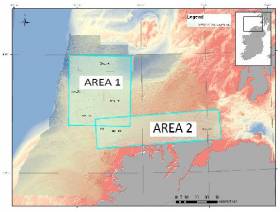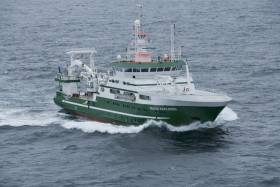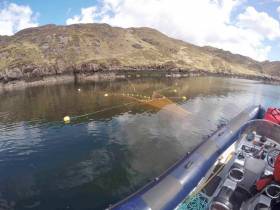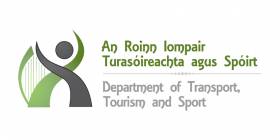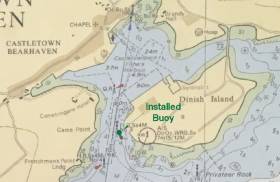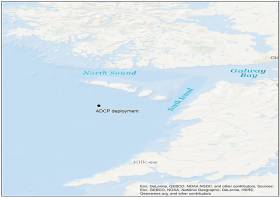Displaying items by tag: Marine Notice
Geophysical Research Survey Off North West Coast In May
#MarineNotice - Maynooth University will carry out a geophysical research survey off the North West Coast of Ireland from next weekend.
Work is expected to commence on Sunday 6 May and last for approximately nine days, subject to weather conditions.
The Marine Institute’s research vessel RV Celtic Voyager (Callsign EIQN) is scheduled to carry out the works for the Mara survey, undertaken by researchers in Maynooth University to collect geophysical acoustic survey data as well as sediment grab and core samples.
The survey will use relatively low amplitude sound sources to image into the seabed including an echosounder and a sparker system, which will allow for the characterisation of seabed type to inform the deglacial dynamics of the climatically driven British Irish Ice Sheet.
The vessel will, on occasion, be towing a hydrophone cable and other equipment, up to a maximum of 50 metres behind the vessel. The vessel will be restricted in its movements when towing a cable astern.
All other vessels are requested to give the operation a wide berth. The vessel will be listening on VHF Channel 16 throughout the project.
Details of the survey area, relevant co-ordinates and contact information are included in Marine Notice No 19 of 2018, a PDF of which is available to read or download HERE.
#MarineNotice - Hydrographic and geophysical surveys will be undertaken in the Celtic Sea and Atlantic Ocean under the INFOMAR (Integrated Mapping for the Sustainable Development of Ireland’s Marine Resources) programme until October 2018.
Geological Survey Ireland vessels the RV Keary (Callsign EI-GO-9), RV Geo (Callsign EI-DK-6), RV Tonn (Callsign EI-PT-7), RV Mallet (Callsign EI-SN-9) and RV Lir (Callsign EI-HI-2) are already involved in scheduled surveys since March.
Marine Institute vessels the RV Celtic Explorer (Callsign EIGB) and RV Celtic Voyager (Callsign EIQN) will begin surveys this weekend, starting with the former vessel on a three-week survey from Sunday 22 April.
The Celtic Voyager and the Celtic Explorer will be towing a magnetometer sensor with a single cable of up to 200 metres in length. The vessels will display appropriate lights and markers, and will be listening on VHF Channel 16 throughout the course of the surveys.
Details of co-ordinates for these surveys are included in Marine Notice No 18 of 2018, a PDF of which is available to read or download HERE.
Note that the Atlantic Ocean Area may not be surveyed in 2018, but if for operational reasons the survey does take place, it will be during the dates set out above for the Celtic Voyager surveys listed therein. In that event, the Marine Notice will be updated with specific dates.
#MarineNotice - Inland Fisheries Ireland (IFI) will be carrying out scientific sampling using bag nets and sentinel cages in Killary Harbour and surrounding waters.
Similar to last year’s operation, the bag nets will start at the shore and extend into the water approximately 25 meters. The sentinel cages (nets) will be anchored near shore and will not interfere with navigable waters.
All nets will be clearly marked with brightly coloured buoys with IFI identification so that any unintentional retrieval can be notified.
Deployment operations, which were set to begin on Thursday 12 April, are being carried out using the RIB Sea Breeze (Callsign EI-5724) and are subject to weather conditions. The nets will be checked daily, also weather dependent, and all sampling nets and buoys will be retrieved on Friday 8 June.
Full details of co-ordinates and contact information are included in Marine Notice No 17 of 2018, a PDF of which is available to read or download HERE.
2018 Anglerfish & Megrim Survey Begins Today
#MarineNotice - The Marine Institute’s annual Irish Anglerfish and Megrim Survey (IAMS) for 2018 is scheduled to resume today, Tuesday 10 April.
After January's survey off the West and South Coasts, this month's survey will be carried out till Saturday 21 April off the North and North West Coasts of Ireland in fulfilment of Ireland’s Common Fisheries Policy obligations.
The IAMS is a demersal trawl survey consisting of approximately 50 otter trawls of 60 minutes duration in ICES area 6a. Fishing will take place within a three nautical mile radius of the positions indicated in Marine Notice No 15 of 2018, a PDF of which is available to read or download HERE.
Survey operations will be conducted by the RV Celtic Explorer (Callsign EIGB), which will display all appropriate lights and signals during the survey and will also be listening on VHF Channel 16.
The vessel will be towing a Jackson demersal trawl during fishing operations. The Marine Institute requests that commercial fishing and other marine operators keep a three nautical mile area around the tow points clear of any gear or apparatus during the survey period outlined above.
Specifics of any fishing gear or other obstructions that are known and cannot be kept clear of these survey haul locations can be notified using the contact details provided in the Marine Notice.
Marine Notice: Remedial Works At Bundoran Outfall
#MarineNotice - Marine Notice No 14 of 2018 advises that as part of the Donegal Group B Sewerage Scheme, remedial works are being carried out this week by Norfolk Marine at the Bundoran outfall in Donegal Bay.
These works were scheduled to begin on Tuesday 3 April to last for around one week at 54° 28.778’ N and 08° 19.304’ W, conducted from the vessel Chateau Thierry (Callsign EI-HK-6). An additional small boat or RIB will also be involved in the operation as required.
The work vessel will display appropriate lights and markers, and will monitor VHF Channel 16 throughout the project.
Buoy Change At Castletownbere Fishery Harbour Centre
#MarineNotice - Marine Notice No 13 of 2018 advises that the No 3 Green Perch at the entrance to Castletownbere Fishery Harbour Centre in West Cork has been removed due to damage.
The No 3 Green Perch has been replaced by a 1.5m green buoy in position 51° 38’ 49.387” North, 09° 54’ 27.41” West.
The light characteristic is a green flash every five seconds. This buoy will remain in position until further notice.
For safety reasons, mariners are requested to proceed slowly and with caution when in the vicinity of the green buoy.
For further information, contact the Castletownbere Harbourmaster’s Office at +353 27 70220.
Marine Notice No 12 of 2018 advises that the Marine Institute was scheduled to deploy a bottom-mounted acoustic Doppler current profiler (ADCP) on the Aran prawn ground today, Monday 26 March.
The ADCP will be recovered in May and will remain in place for the duration. The purpose of this deployment is to measure water current speed over a depth range using the Doppler effect of sound waves scattered from particles within the water column.
The ADCP was set to be deployed at Latitude 53°46.133 N and Longitude 9°47.4 W by the RV Celtic Voyager (Callsign EIQN) listening on VHF Channel 16.
As this is sensitive scientific equipment, it is requested that fishermen and marine operators engaged in such activities as bottom trawling or laying of static gear avoid the location concerned to avoid damaging the equipment or damaging fishing gear.
Prohibitions on the Consumption of Alcohol and/or Drugs When Operating Recreational Craft
The Irish Maritime Administration at the Department of Transport, Tourism and Sport has issued a Marine Notice to remind the public of the law in relation to being under the influence of alcohol and / or drugs when operating or while on board a recreational craft or any vessel in Irish waters, or on board vessels or objects being towed by recreational craft.
The recently published Annual Report of the Marine Casualty Investigation Board (MCIB) highlights the fact that alcohol or drug consumption continues to be a factor in marine incidents, including incidents involving recreational craft. Successive MCIB Annual Reports have shown that incidents are occurring where diminished human performance and impairment due to the effects of alcohol and / or drug consumption have been primary causes or contributing factors, leading to the loss of life in some cases. In the recent Annual Report, the MCIB Board reminds all vessel operators of the need to take personal responsibility and to ensure that they are fit to undertake their planned voyage.
The Department of Transport, Tourism and Sport wishes to remind all recreational craft users that it is the responsibility of each individual taking to the water to be mindful of their own safety:
• YOU must take personal responsibility for your actions on the water.
• YOU must avoid alcohol and drugs before or during a voyage.
• If you fail to operate safely and to comply with the law in relation to alcohol and drug consumption YOU put your life and your vessel at risk as well as the lives of others, including members of the rescue services.
• It is against the law to consume alcohol and drugs in circumstances that could affect the safety of others on board or others using Irish waters, or create a disturbance on board or be a nuisance to others using Irish waters.
• Alcohol speeds up the rate of body cooling and thus increases the risk of hypothermia in the event that you fall into the water.
Regulations 8 and 9 of the Pleasure Craft (Personal Flotation Devices and Operation) (Safety) Regulations 2005 [S.I. No. 921 of 2005], as amended, set out the law regarding the consumption of alcohol or drugs while on board a pleasure craft, including prohibitions on operating a pleasure craft while under the influence. Failure to comply with the law can result in a fixed payment of €150 and/or prosecution proceedings which, on summary conviction, can lead to a fine of up to €5,000. A pleasure craft includes personal watercraft, such as jet skis, and fast power craft.
Sections 28 to 30 of the Maritime Safety Act 2005 (No. 11 of 2005) contain a range of provisions relating to the prohibition on operating or being on board a vessel in Irish waters while under the influence of alcohol or drugs, and the associated penalties. These include the following prohibitions:
1. A person in command or in charge or another member of the crew of a vessel in Irish waters (or an Irish ship in waters anywhere) must not operate or control or attempt to operate or control the vessel or carry out any task or duty in relation to the operation or control of the vessel while he or she is under the influence of alcohol or a drug or any combination of drugs, or drugs and alcohol to such an extent as to be incapable of properly controlling or operating the vessel or carrying out the task or duty (section 28).
2. A person on board a vessel in Irish waters (or an Irish ship in waters anywhere) must not consume alcohol or take a drug or any combination of drugs or drugs and alcohol while on board the vessel in circumstances which could affect the safety of persons or create a disturbance or serious nuisance on board the vessel or affect the safety of other persons using Irish waters or constitute a nuisance to such persons (section 30).
3. Failure to comply with the above requirements is an offence and the person is liable on summary conviction to a fine not exceeding €5,000 or to imprisonment for a term not exceeding 3 months or both.
4. If a person in command or in charge or another member of the crew of a vessel is, while on duty, under the influence of alcohol or a drug or any combination of drugs or drugs and alcohol to such an extent that his or her ability to discharge his or her duties is impaired, he or she commits an offence and is liable on summary conviction to a fine not exceeding €5,000 (section 29).
5. A person on board a vessel in Irish waters (or on an Irish ship in waters anywhere) who through any deliberate or reckless action or by reason of being under the influence of alcohol or a drug or any combination of drugs or drugs and alcohol puts at risk or endangers the safety, security or seaworthiness of the vessel or the lives or safety of persons on board commits an offence and is liable on summary conviction to a fine not exceeding €5,000 or to imprisonment for a term not exceeding 6 months or both, or on conviction on indictment, to a fine not exceeding €100,000 or to imprisonment for a term not exceeding 2 years or both (section 32).
Irish Maritime Administration
Department of Transport, Tourism and Sport
Leeson Lane, Dublin 2, D02 TR60, Ireland.
Marine Notice: Cable Route Survey In Irish Territorial Waters
#MarineNotice - Fugro is currently carrying out marine operations for the HAVFRUE Subsea Cable System Project, further to its work carried out in January.
The current survey within Irish territorial waters off the North West Coast began on Wednesday 14 March and is expected to run till midweek next week.
The MV Fugro Discovery (Callsign 3EKE6) is surveying on Segment 2 within Irish EEZ waters towards the 1,500m contour line at the shelf, followed by operations at the BU1 position and Segment 3 as indicated on the charts included with Marine Notice No 10 of 2018, a PDF of which is available to read or download HERE.
Guidelines On Maritime Cyber Risk Management
#Ports&Shipping - The Department of Transport, Tourism and Sport (DTTAS) has issued an advisory to the maritime sector to make cybersecurity an integral part of their risk assessment exercises and continuity plans.
At the Maritime Safety Committee (MSC) of the International Maritime Organization (IMO) in 2017, measures were agreed in relation to the cyber risk being taken into account by shipping companies in respect of the International Safety Management Code.
Resolution MSC 428(98) calls for cyber risks to be appropriately addressed in safety management systems no later than the first annual verification of the company's Document of Compliance after 1 January 2021.
The IMO has also published guidelines on cybersecurity for the industry, included in Marine Notice No 08 of 2018, a PDF of which is available to read or download HERE.
In relation to ports, the approach that the DTTAS is planning to take in Ireland is to incorporate a cybersecurity risk element in the security assessments which are carried out in accordance with Regulation (EC) No 725/2004 1 and Directive 2005/65/EC 2 in our ports and port facilities.
The next five-yearly renewal of these assessments is due in all Irish ports by 30 June 2019.




























